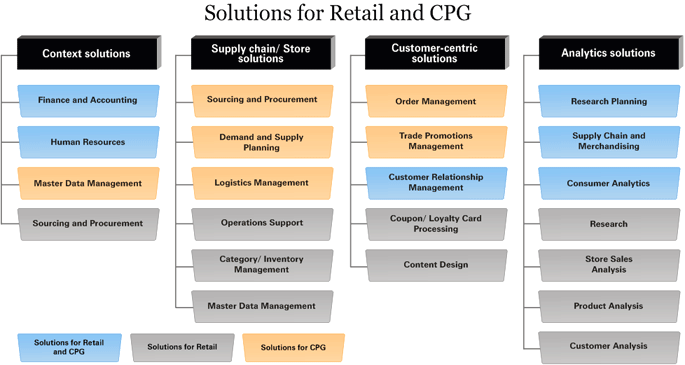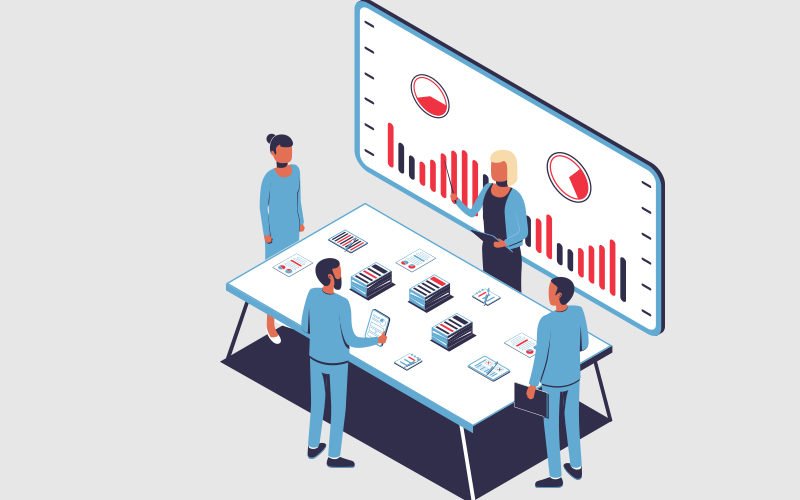Retail, CPG and Logistics
Supply chain solutions and trends for the CPG industry
Rapidly evolving market scenario in the consumer packaged goods (CPG) industry is unrelenting. The global trade slowdown is being considered the new normal - in no small measure - due to rising trade barriers, renewed financial stress, sharper-than-expected slowdowns in several major economies, the fear of epidemics, climate changes, and a new breed of digitally connected consumers. Even giant brands that wish to secure a safe spot in the industry are feeling the pressure to scale up their game. They are looking for options to revamp their cpg supply chain processes, invest in neoteric technology structures, design innovative products, and customize consumers’ experience. The industry is also seeing a tidal wave of smaller players taking up a sizable market share.
In order to succeed, they have to improve their processes through digitalization, drive profitability with higher volumes and prices, and achieve cost reduction. Industry leaders are facing the challenges of unprecedented change and increased competition. They have to balance between the need to invest in new technologies and being prudent in investment strategies, to keep up with their dynamic consumer base.
Supply chain opportunities to stay ahead of competition
New consumers in emerging markets (globalization):
With economically emerging countries in Asia, such as China, India, and Indonesia, contributing a significant share in the global economy in the last decade, the market will see a rise in new consumers from this region. This growth is expected to rise significantly in the next decade with the increase in the middle class purchasing power globally. Understanding this new customer base will pose a challenge to the CPG leaders, especially to those who are based in the West. They will need to consider how this new trend will affect their businesses and how they can navigate and use it to their advantage.Digitalization:
In today’s digitally connected society, consumers are clear about their wants and are actively searching for quick, easy, and hassle-free services with a positive experience. Social media platforms, mobile platforms, and apps provide instant access to public product reviews and ratings from other buyers. This enables people to compare the prices and quality of goods and services in the market and make the right purchasing decisions. CPG companies, therefore, need to have an effective demand management program to overcome the complexities and costs of delivering a consistently holistic experience to consumers. For this, they need to survey, analyse and strategically invest in customer-centric technologies.Omni-channel supply chains:
In response to increasing customer demands, building the capability to provide a seamless omni-channel buying experience is highly beneficial to CPG companies. Products and services should be made available to buyers via online shops as well as in brick-and-mortar stores. However, to ensure availability on both platforms, CPG businesses should re-evaluate their supply chain logistics.Sustainability and rise in environmentalism:
With climate change becoming a major issue and the growing awareness of a more sustainable, carbon-free environment, buyers are now leaning toward eco-friendly goods and organic, green products. Sustainability is now becoming a key trend in the global supply chain. Recycling and re-use is not only imperative but is a competitive differentiation for brands and their social image. Biodegradable packaging and retrieval of unconsumed products are becoming critical for CPG companies. This also gives rise to a new era of consumerism as manufacturers will feel pressured to produce locally and import fewer goods to achieve significant waste reduction.Big data:
Big data is an inevitable by-product of the current business processes. Companies have enormous amounts of data to use in business intelligence - enabling proactive decision making through analysing past data and predicting future opportunities. To stay ahead, CPG firms will need to use big data analytics to determine customer preferences and market trends as well as redefine the supply chain.Artificial intelligence, robotics, and automation:
Artificial intelligence coupled with big data is setting the pace in global logistics and supply chain management through business insights to improve customer service. AI improves crucial processes, such as planning and decision support, identifying purchasing patterns, automating tedious warehousing functions, and managing inventory. Various algorithms are used to analyse data, enhance data quality, and identify transparency issues. Furthermore, with the need for flexibility and agility, many businesses are turning to robotics to speed up labour-intensive tasks. With boundless possibilities, robotics is already being used in the supply chain to track, locate, and move inventory within warehouses. Investing heavily in AI and robotics will prove to be a smart move for future progress.
Transforming the supply chain function to keep pace with these trends can help businesses in:
- Building supplier relationship management as a core competency
- Prioritizing value creation over price management
- Transferring innovation strategy for supply chain success
- Maintaining focus on portable manufacturing
- Creating workforce backup for business contingency
- Building internal and external collaboration at the business front
- Aligning business strategy to supply chain
- Prioritizing distribution, logistics, and asset management
- Bringing agility, flexibility, integration, transparency, and alignment to dominate the competition
- Shortening product life cycles
How does outsourcing drive business value in retail, CPG, and logistics
Supply chain is the main driving force of CPG outsourcing-companies. Companies therefore need to consistently analyse, evaluate, and review their operations to close loopholes and improve business. Outsourcing partners understand their clients’ challenges and deliver tangible business value through their technology, process, and domain expertise. Outsourcing helps:
- Define strategy through a discovery process and a blueprint to solve problems
- Design shared services models across geographies
- Manage complex transitions
- Ensure superior quality of delivery despite complexity
- Provide a diverse workforce with capabilities that complement the client’s business needs







